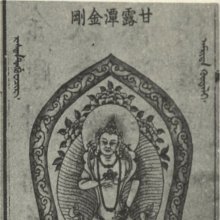Amritakundalin, Amṛtakuṇḍalin: 1 definition
Introduction:
Amritakundalin means something in Buddhism, Pali. If you want to know the exact meaning, history, etymology or English translation of this term then check out the descriptions on this page. Add your comment or reference to a book if you want to contribute to this summary article.
The Sanskrit term Amṛtakuṇḍalin can be transliterated into English as Amrtakundalin or Amritakundalin, using the IAST transliteration scheme (?).
Images (photo gallery)
In Buddhism
Tibetan Buddhism (Vajrayana or tantric Buddhism)
Source: Wisdom Library: Tibetan BuddhismAmṛtakuṇḍalin (अमृतकुण्डलिन्) refers to one of the male Vidyā-beings mentioned as attending the teachings in the 6th century Mañjuśrīmūlakalpa: one of the largest Kriyā Tantras devoted to Mañjuśrī (the Bodhisattva of wisdom) representing an encyclopedia of knowledge primarily concerned with ritualistic elements in Buddhism. The teachings in this text originate from Mañjuśrī and were taught to and by Buddha Śākyamuni in the presence of a large audience (including Amṛtakuṇḍalin).
Source: De Gruyter: A Fragment of the VajrāmṛtamahātantraAmṛtakuṇḍalin (अमृतकुण्डलिन्) or Amṛtakuṇḍalī is the name of a deity as defined in the ‘śrī-amṛtakuṇḍalin-utpatti’ chapter of the 9th-century Vajrāmṛtatantra or Vajrāmṛtamahātantra: one of the main and earliest Buddhist Yoginītantras. Chapter 9 begins with the visualisation of Amṛtakuṇḍalin: he has three faces and six arms, is fierce and appears black like the newly split antimony; he is surrounded by a garland of flames, he is cruel, and he is endowed with reddish-brown eyes; he is crushing the Great Obstacle(s) under his feet; his fist is raised, holding a hatchet; with his left hands he holds a club, a vajra and a noose. His forefinger is threatening all evil beings. The practitioner should visualize a sword in his hand; afterwards, he should visualize the eight Wisdoms along with the door-guardians; eventually he should project the eight Wisdoms into the petals.

Tibetan Buddhism includes schools such as Nyingma, Kadampa, Kagyu and Gelug. Their primary canon of literature is divided in two broad categories: The Kangyur, which consists of Buddha’s words, and the Tengyur, which includes commentaries from various sources. Esotericism and tantra techniques (vajrayāna) are collected indepently.
See also (Relevant definitions)
Starts with: Amritakundalyutpatti.
Full-text: Amritalocana, Varuna, Surupa, Amrita, Aprameya, Amritavajra, Sukhasadhani, Amritakundali, Amritakundalyutpatti.
Relevant text
Search found 3 books and stories containing Amritakundalin, Amṛtakuṇḍalin, Amrtakundalin; (plurals include: Amritakundalins, Amṛtakuṇḍalins, Amrtakundalins). You can also click to the full overview containing English textual excerpts. Below are direct links for the most relevant articles:
Guhyagarbha Tantra (with Commentary) (by Gyurme Dorje)
Text 4.24 (Commentary) < [Chapter 4 (text and commentary)]
Text 1.13 (Commentary) < [Chapter 1 (text and commentary)]
Introduction 1.1: The Ritual associated with the site < [Chapter 9 (Text And Commentary)]
The Great Chariot (by Longchenpa)
Part 4a.3 - Meditating on the deities < [B. The explanation of meditation practice, together with its action of ripening and freeing]
Part 4a.1 - Meditation on the protection circles < [B. The explanation of meditation practice, together with its action of ripening and freeing]
Part 4a.4 - The great mandala of the environment and inhabitants < [B. The explanation of meditation practice]
A Dictionary Of Chinese Buddhist Terms (by William Edward Soothill)
Related products
